2021 MERCEDES-BENZ GLS SUV warning
[x] Cancel search: warningPage 209 of 510
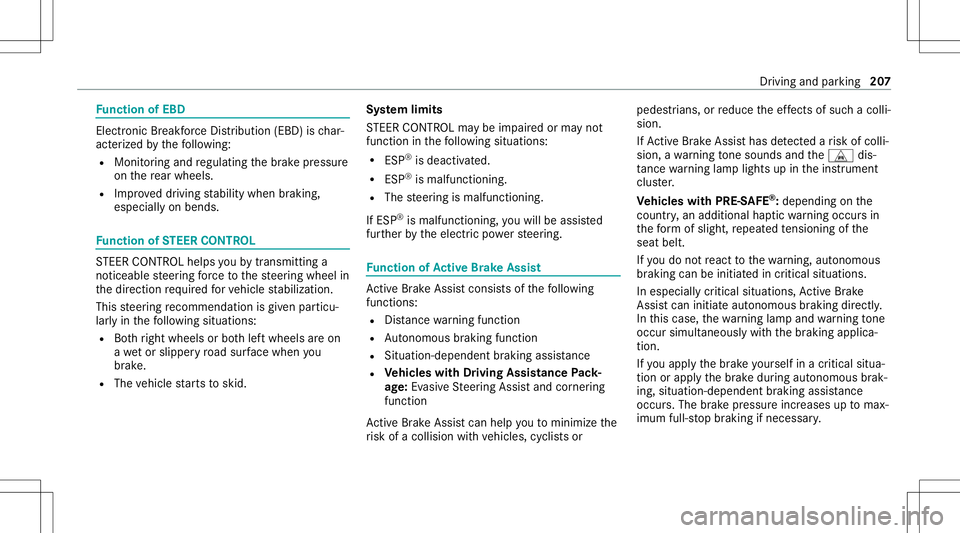
Fu
nction ofEBD Elect
ronic Brea kfor ce Dis trib uti on (EBD) isch ar‐
act erize dby thefo llo wing:
R Mon itor ing and regulating thebr ak epr essur e
on there ar wheels .
R Improv ed driving stabilit ywhen brakin g,
espe ciallyon ben ds. Fu
nction ofSTEER CONT ROL ST
EER CONTR OLhelpsyo uby trans mitting a
no tice ablesteer ing forc eto thesteer ing wheel in
th edir ect ion requ ired forve hicle stabiliz ation.
This steer ing recomme ndation isgiv en particu‐
lar lyin thefo llo wing situat ions:
R Both right wheels orboth leftwheels areon
a we tor slip pe ry road sur face whe nyo u
br ak e.
R The vehicle star ts to skid. Sy
stem limit s
ST EER CONTR OLmaybe impa ired orma yno t
fu nctio nin thefo llo wing situat ions:
R ESP®
is deact ivat ed.
R ESP®
is malfun ctionin g.
R The steer ing ismalfunct ioning.
If ES P®
is malfunct ioning,youwill beassis ted
fur ther by theelectr icpo we rst eer ing. Fu
nction ofActiv eBr ak eAs sist Ac
tiveBr ak eAssi stconsi stsof thefo llo wing
func tions:
R Distance warning func tion
R Autonomo usbraki ng func tion
R Situ ation-d epend ent braki ng assist anc e
R Vehicl eswith Drivin gAss istanc ePa ck‐
ag e:Evasi ve Steer ing Assis tand corner ing
func tion
Ac tiveBr ak eAssi stcan helpyo uto minimize the
ri sk ofacollision withve hicles, cyclis tsor pedes
trians, orreduce theef fects ofsuch acol li‐
sion .
If Ac tiveBr ak eAssi sthas detected arisk ofcolli‐
sion, awa rning tone sou nds and theL dis‐
ta nce warning lam plight sup intheins trument
clus ter.
Ve hicl eswith PRE-S AFE®
:depe nding onthe
cou ntry,an addit ionalhap ticwarning occursin
th efo rm ofslight, repeat edtensi oni ng ofthe
seat belt.
If yo udo notre act tothewa rning, autono mous
br akin gcan beinit iated incritic alsituat ions.
In espec iallycritic alsituat ions,Ac tiveBr ak e
Assi stcan initia te aut onomo usbrakin gdir ect ly.
In this case, thewa rning lam pand warning tone
occu rsi mu ltane ously with thebr aking applica‐
tion .
If yo uappl yth ebr ak eyo urself inacr itical situa‐
tio nor appl yth ebr ak edur ing autonomous brak‐
ing, situation -dependen tbr aking assistance
occu rs.The brak epr ess ureincr eases uptomax‐
imum full-sto pbr aking ifnec essar y. Dr
iving and parking 20
7
Page 210 of 510
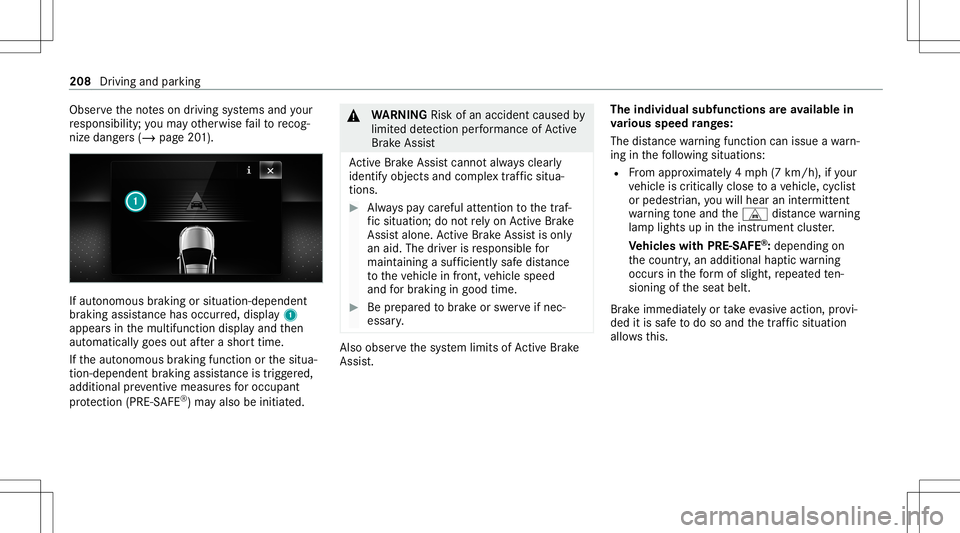
Obser
vetheno teson driving systems andyour
re sponsibili ty;yo uma yot her wise failto recog‐
nize dangers(/ page 201). If
au tonomo usbraki ng orsitua tion-de pende nt
br aki ng assist anc ehas occurred, displa y1
appear sin themultifunc tiondispla yand then
aut omaticall ygoes outafte ra shor ttime.
If th eaut onomous braking function orthesitua‐
tion -dependen tbr aking assistance istrig ge red,
additional preve ntiv emea suresfo roccupa nt
pr otect ion (PRE-S AFE®
)ma yalso beinitiat ed. &
WARNIN GRisk ofan acci dent caused by
limit eddetection perform anc eof Active
Br ak eAssi st
Ac tiveBr ak eAssi stcanno tal wa ys cle arly
ident ifyobje ctsand complextraf fic situ a‐
tions . #
Alw ayspa ycar eful attention tothetra f‐
fi c situ ation; donotre ly on ActiveBr ak e
Assi stalon e.Ac tiveBr ak eAssi stisonl y
an aid. Thedriver isresponsible for
maint ainingasuf ficie ntly safedist anc e
to theve hicle infront, vehicle speed
and forbr aking ingood time. #
Beprepa redto brak eor sw erve ifnec ‐
essar y. Als
oob ser vethesy stem limits ofActiveBr ak e
Assi st. The
indiv idua lsub func tions areav ailab lein
va rious speed rang es:
The distance warning func tion canissue awa rn‐
ing inthefo llo wing situat ions:
R From appr oximat ely4 mp h(7 km/h), ifyo ur
ve hicle iscritically closetoave hicle, cyclis t
or pedes trian, youwill hear anintermit tent
wa rning tone and theL distance warning
lam plight sup intheins trument cluster.
Ve hicl eswith PRE-S AFE®
:depe nding on
th ecount ry,an addition alhap ticwarning
occ ursin thefo rm ofslight, repeat edten‐
si oni ng oftheseat belt.
Br ak eimmediat elyortake evasiv eact ion,pr ov i‐
ded itis saf eto do soand thetraf fic situ ation
al lo ws this. 208
Drivin gand parking
Page 211 of 510
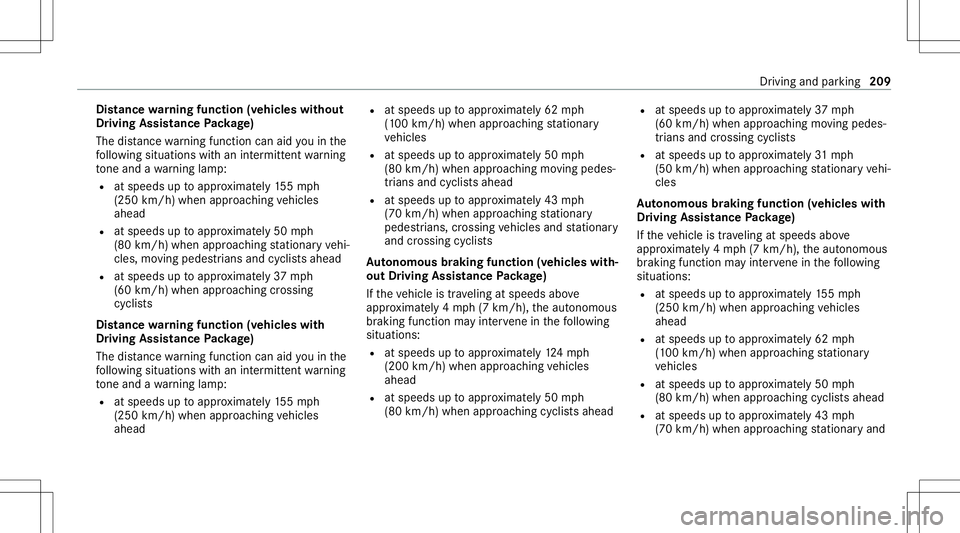
Dis
tance warning funct ion(vehicles without
Dr iving Assistance Packag e)
The distance warning func tion canaidyouin the
fo llo wing situat ionswithan intermit tent wa rning
to ne and awa rning lam p:
R atspeeds uptoappr oximat ely15 5mp h
(250 km/h)when approaching vehicles
ahead
R atspeeds uptoappr oximat ely50 mph
(80 km/ h)when approaching statio naryve hi‐
cles, moving pedes trians andcyclis tsahead
R atspeeds uptoappr oximat ely37 mph
(60 km/ h)when approaching crossin g
cy clis ts
Dis tance warning funct ion(vehicles with
Dr iving Assistance Packag e)
The distance warning func tion canaidyouin the
fo llo wing situat ionswithan intermit tent wa rning
to ne and awa rning lam p:
R atspeeds uptoappr oximat ely15 5mp h
(250 km/h)when approaching vehicles
ahead R
atspeeds uptoappr oximat ely62 mph
(1 00 km/ h)when approaching statio nary
ve hicles
R atspeeds uptoappr oximat ely50 mph
(80 km/ h)when approaching moving pedes‐
tr ians andcyclis tsahead
R atspeeds uptoappr oximat ely43 mph
(70 km/ h)when approaching statio nary
pedes trians ,cr oss ing vehicles andstatio nary
and cross ing cyclis ts
Au tonomous braking function (vehicles with‐
out Driving Assistance Packag e)
If th eve hicle istrave ling atspeeds above
appr oximat ely4 mp h(7 km/h), theaut onomous
br aking function mayint erve ne inthefo llo wing
situat ions:
R atspeeds uptoappr oximat ely12 4mp h
(200 km/h)when approaching vehicles
ahead
R atspeeds uptoappr oximat ely50 mph
(80 km/ h)when approaching cyclis tsahead R
atspeeds uptoappr oximat ely37 mph
(60 km/ h)when approaching moving pedes‐
tr ians andcrossin gcy clis ts
R atspeeds uptoappr oximat ely31 mp h
(50 km/ h)when approaching statio naryve hi‐
cles
Au tonomous braking function (vehicles with
Dr iving Assistance Packag e)
If th eve hicle istrave ling atspeeds above
appr oximat ely4 mp h(7 km/h) ,th eaut onomous
br aking function mayint erve ne inthefo llo wing
situat ions:
R atspeeds uptoappr oximat ely15 5mp h
(250 km/h)when approaching vehicles
ahead
R atspeeds uptoappr oximat ely62 mph
(1 00 km/ h)when approaching statio nary
ve hicles
R atspeeds uptoappr oximat ely50 mph
(80 km/ h)when approaching cyclis tsahead
R atspeeds uptoappr oximat ely43 mph
(70 km/ h)when approaching statio naryand Dr
ivin gand parking209
Page 214 of 510

Multimedia
system:
4 © 5
Set ting s5
Assist ance
5 Act ive Brak eAssist #
Select thedesir edsetting.
The setting isretained when theengine is
ne xt star ted.
Deactiv atingActiv eBr ak eAs sist
% Itis recomme ndedthat youalw ayslea ve
Ac tiveBr ak eAssi stact ivat ed. #
Select Off.
The distance warning func tion,th eaut ono‐
mous braking function andtheEv asiv eSt eer‐
ing Assis tar edeactiv ated.
When theve hicle isne xt star ted, themiddle
se tting isaut omaticall yselect ed.
% IfAc tiveBr ak eAssi stisdeact ivat ed, the
00D4 symbol appearsinthest atus barofthe
multifu nctiondisplay. Speed
controlcruise contr ol Fu
nction ofcruise contr ol
Cr uise controlre gulat esthespeed totheva lue
selec tedby thedr iver .
If yo uacc elerat eto ove rtak e, forex am ple, the
st or ed speed isno tdele ted. Ifyo ure mo veyour
fo ot from theacceler ator pedal afte rove rtakin g,
cr uise control will resume speed regulation back
to thestor ed speed.
Cr uise controlis oper ated using thecor respond‐
ing steer ing wheel buttons. Youcan stor ean y
speed above15 mp h(2 0km/h) uptothemaxi‐
mum design speed.
Obser vetheno teson driving systems andyour
re sponsibili ty;yo uma yot her wise failto recog‐
nize dangers(/ page 201).
Mer cedes‑A MGvehicl es:Cruis econtr olis
av ailable uptoamax imum speedof 155mp h
(250 km/h).
Displa yson themu ltifunct iondisp lay
R h (gra y): cruise contro lis selec tedbut
no tye tacti vated.
R h (green): cruise control isactiv e. A
stor ed speed appear salong withth eh dis‐
pla y.
% The segment sbe tween thestor ed speed and
th eend ofthesegment displaylight upin
th espeedome ter.
Sy stem limit s
Cr uise control ma ybe unable tomaint ainthe
st or ed speed onuphill gradients. Thestor ed
speed isresumed whenthegr adient evensout.
Ch ang eint oalowe rge ar ingood timeon long
and steep downhill gradients. Take par ticular
no te ofthis when drivin galaden vehicle. By
doing so,youwill mak euse ofthebr aking effect
of theengine. Thisrelie vesth eload onthebr ak e
sy stem and preve nts thebr ak es from overheat‐
ing and wearing tooqu ickl y.
Do notus ecr uise contr olinthefo llo wing situa‐
tion s:
R Intraf fic situ ations whichrequ ire freq uent
ch ang esofspee d,e.g .in hea vytraf fic, on
wi nding roads.
R Onslippe ryroads. Accel erati ng can cause
th edr ive wheels tolose tract ion and the
ve hicle could then skid. 21
2
Driving and parking
Page 219 of 510
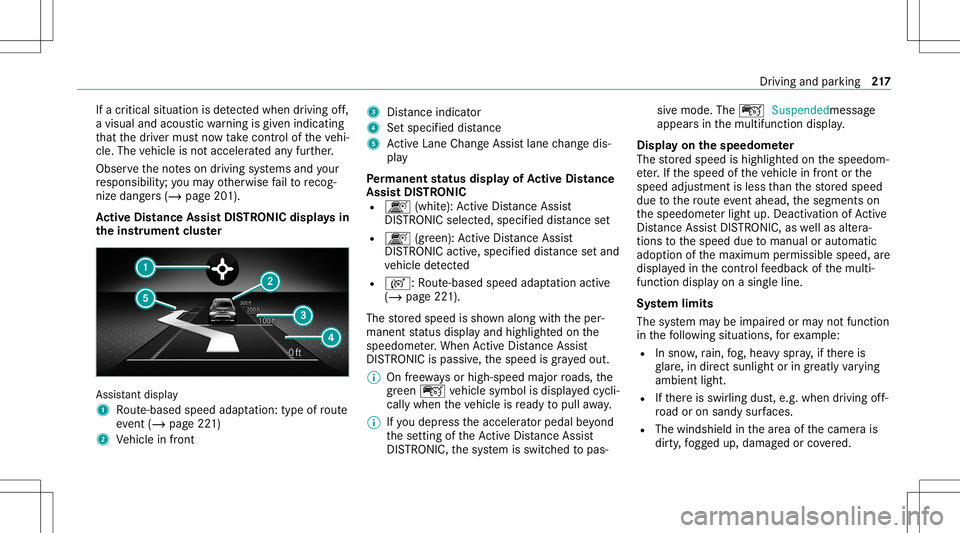
If
acr itical situationisde tected whe ndr ivi ng off,
a vis ualand acoustic warning isgiv en indic ating
th at thedr iver mus tno wtake contr olof theve hi‐
cle. The vehicle isno tacceler ated anyfur ther.
Obser vetheno teson driving systems andyour
re sponsibili ty;yo uma yot her wise failto recog‐
nize dangers(/ page 201).
Ac tiv eDi stance AssistDI ST RO NIC displa ysin
th eins trum ent clus ter Assi
stant displa y
1 Route-based speedadap tatio n:typ eof route
eve nt(/ page 221)
2 Vehicle infront 3
Distance indicator
4 Setspe cified dist anc e
5 ActiveLa ne Chang eAssi stlane chang edis‐
pla y
Pe rm anen tst atus displa yof Activ eDi stance
Ass istDI ST RO NIC
R k (white ):Ac tiveDis tance Assist
DIS TRONI Csel ect ed,sp eci fied distance set
R k (green): ActiveDis tance Assist
DIS TRONI Cacti ve,specif ieddistance setand
ve hicle detected
R r: Route-based speedadap tatio nacti ve
( / pag e22 1).
The stor ed speed issho wnalong withth eper‐
manen tst atus displa yand highlight edon the
speedome ter.When ActiveDis tance Assist
DIS TRONI Cis pa ssi ve,th espeed isgray ed out.
% Onfree wa ys orhigh-speed major roads, the
gr een ç vehicle symbol isdispla yedcy cli‐
cally when theve hicle isready topull away.
% Ifyo udepr esstheacceler ator pedal beyond
th ese tting oftheAc tiveDis tance Assist
DIS TRONI C,thesy stem isswitc hedtopas‐ siv
emode. Theç Suspen dedmessag e
appear sin themultifunc tiondispla y.
Disp layon thespeed ometer
The stor ed speed ishighlight edon thespeedom‐
et er.If th espeed oftheve hicle infront orthe
speed adjustment isless than thestor ed speed
due tothero uteeve ntahead, thesegmen tson
th espeedome terlig ht up. Deactiv ationofActive
Dis tance AssistDIS TRONI C,as wellas altera‐
tion sto thespeed duetomanua lor automatic
adop tionofthemaximum permissible speed,are
displa yedin thecon trol feedbac kof themulti‐
func tion displa yon asing leline.
Sy stem limit s
The system maybe impair edorma yno tfunc tion
in thefo llo wing situat ions,fo rex am ple:
R Insnow ,ra in, fog, hea vyspr ay,if th er eis
gl ar e, indir ect sunlight oringrea tly varying
ambien tlight .
R Ifth er eis swir ling dust,e.g. when driving off-
ro ad oron san dysur faces.
R The windsh ield inthear ea ofthecamer ais
dir ty,fo gg ed up, damag edorcovered. Dr
iving andparking 217
Page 220 of 510
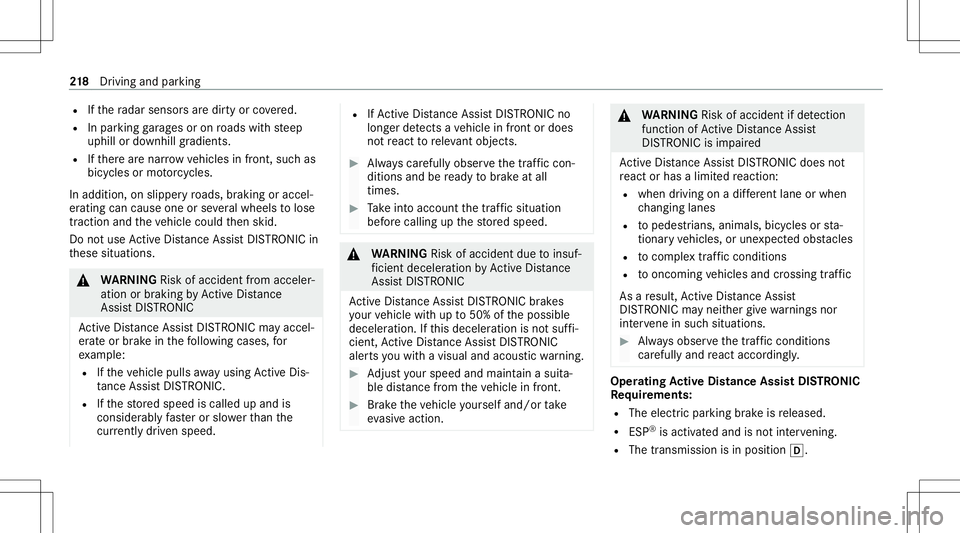
R
Ifth era dar sensor sar edir tyor covered.
R Inpar kingga rage sor on roads withsteep
uphill ordownhill gradients.
R Ifth er ear enar row vehicles infront, suchas
bicy cles ormo torcyc les.
In addition ,on slipper yro ads, brakin gor acc el‐
er atin gcan caus eon eor severalwheels tolose
tr act ion and theve hicle could then skid.
Do notuse ActiveDis tance AssistDIS TRONI Cin
th ese situation s. &
WARNIN GRisk ofacci dent from acce ler‐
ati on orbraki ng byActiveDis tance
Assi stDIS TRONI C
Ac tiveDis tance AssistDIS TRONI Cma yacc el‐
er ateor brak ein thefo llo wing cases ,fo r
ex am ple:
R Ifth eve hicle pullsaway usin gAc tiveDis ‐
ta nce AssistDIS TRONI C.
R Ifth estor ed speed iscalled upand is
considera blyfaster or slo werth an the
cur rently driven spe ed. R
IfAc tiveDis tance AssistDIS TRONI Cno
lo ng er detects ave hicle infront ordoes
no tre act toreleva nt objects. #
Alw ayscar efully observethetraf fic con‐
di tions andbeready tobrak eat all
times. #
Take intoacc ount thetra ffic situat ion
bef orecallin gup thestor ed speed. &
WARNIN GRisk ofacci dent dueto insuf ‐
fi cie ntdece lera tio nby ActiveDis tance
Assi stDIS TRONI C
Ac tiveDis tance AssistDIS TRONI Cbrak es
yo ur vehicle withup to50% ofthepossible
deceler ation.Ifth is decele ratio nis no tsu ffi‐
cien t,Ac tiveDis tance AssistDIS TRONI C
al er ts youwit havis ual and acoustic warning. #
Adjus tyo ur spee dand main tain asuit a‐
ble distance from theve hicle infront. #
Brak eth eve hicle yourself and/or take
ev asiv eact ion. &
WARNIN GRisk ofacci dent ifde tection
functi onofActiveDis tance Assist
DIS TRONI Cis impai red
Ac tiveDis tance AssistDIS TRONI Cdo es not
re act orhas alimit edreact ion:
R when drivin gon adif fere nt lane orwh en
ch ang inglane s
R topedes trians, animals, bicycles orsta‐
tio nar yve hicles, orune xpect edobs tacle s
R tocom plex traf fic condi tions
R tooncom ingvehicles andcrossing traf fic
As are sult, ActiveDis tance Assist
DIS TRONI Cma ynei ther giv ewa rnings nor
int erve ne insuch situations. #
Alw aysobser vethetra ffic con dition s
car efull yand react accordin gly. Oper
ating Activ eDi stance AssistDI ST RO NIC
Re quirement s:
R The elect ric pa rking brak eis released.
R ESP®
is act ivat ed and isno tint erve ning .
R The trans mis sion isin po sitio n005B. 21
8
Driving and parking
Page 225 of 510
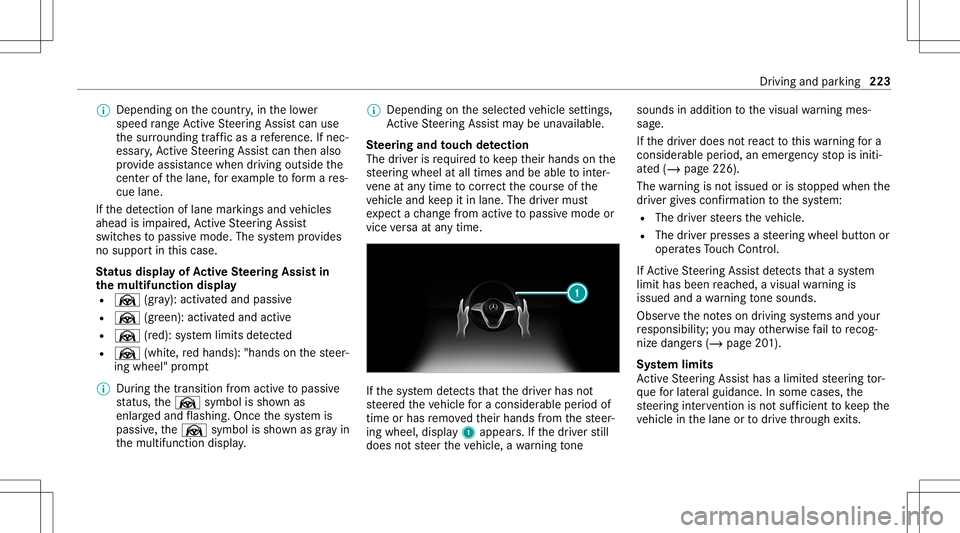
%
Dep endingonthecount ry,in thelowe r
speed rang eAc tiveSt eer ing Assis tcan use
th esur round ingtraf fic as are fere nce. Ifnec‐
ess ary, Ac tiveSt eer ing Assis tcan then also
pr ov ide assis tance when drivi ng outsid eth e
cent erofthelane, forex am ple toform are s‐
cue lane.
If th ede tection oflane mar kings andvehicles
ahead isim pair ed,ActiveSt eer ing Assis t
switc hestopassiv emode. Thesystem prov ides
no suppor tin this case.
St atus displa yof Activ eSte ering Assis tin
th emu ltifunct iondisp lay
R Ø (gra y): act ivat ed and pass ive
R Ø (green ):act ivat ed and active
R Ø (red): system limits detected
R Ø (whit e,redhands): "handsonthesteer‐
ing wheel" prom pt
% During thetransition from activ eto passiv e
st atus ,th eØ symbol issho wnas
enlar gedand flashin g.On ce thesy stem is
passiv e,theØ symbol issho wnasgray in
th emultifunc tiondispla y. %
Dep endingontheselect edvehicle settin gs,
Ac tiveSt eer ing Assis tma ybe una vailable.
Ste ering and touc hde tection
The driver isrequ ired tokeep their hands onthe
st eer ing wheel atall times andbeable tointer‐
ve ne atanytime tocor rect thecour seofthe
ve hicle andkeep itin lane. Thedriver mus t
ex pect ach ang efrom active to passiv emode or
vice versaat anytim e. If
th esy stem detects that thedr iver has not
st eer edtheve hicle fora consider ableper iod of
time orhas remo vedth eir hands from thesteer‐
ing wheel, display1 appear s.Ifth edr iver still
does notst eer theve hicle, awa rning tone sou
nds inad ditio nto thevisual warning mes‐
sag e.
If th edr iver does notre act tothis wa rning fora
consider ableper iod, anemerg encystop isiniti‐
at ed (/ page226).
The warning isno tissued orisstopped whenthe
dr iver giv es con firm atio nto thesy stem:
R The driver steer sth eve hicle.
R The driver presses ast eer ing wheel buttonor
oper ates Touc hCon trol.
If Ac tiveSt eer ing Assis tde tects that asy stem
limit hasbeen reac hed, avisual warning is
issued andawa rning tone sou nds.
Obs erve theno teson driving systems andyour
re sponsibili ty;yo uma yot her wise failto recog‐
nize dangers(/ page 201).
Sy stem limit s
Ac tiveSt eer ing Assis thas alimit edsteer ing tor‐
qu efo rlat eral gui dance. Insome cases, the
st eer ing interve ntio nis no tsu fficien tto keep the
ve hicle inthelane ortodrive th ro ugh exits. Dr
ivin gand parking223
Page 233 of 510
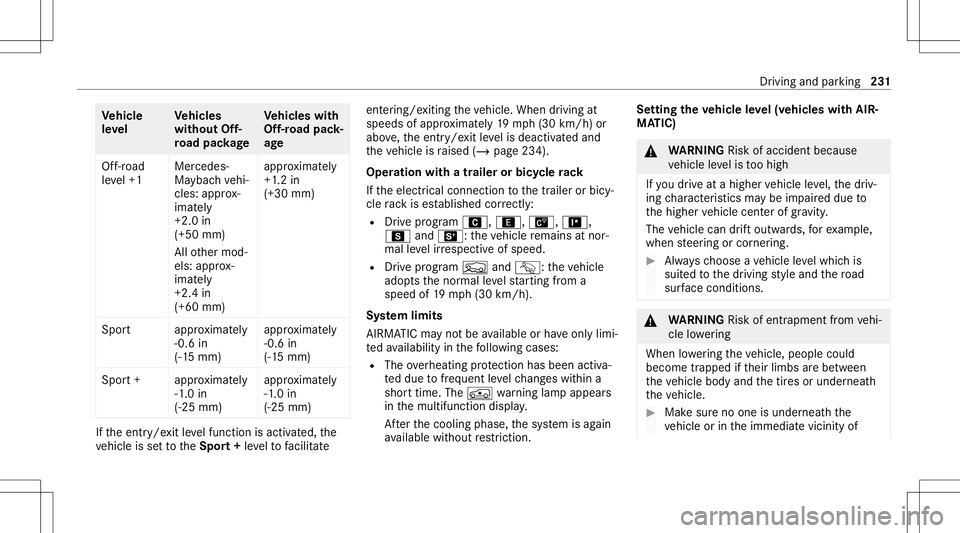
Ve
hicl e
le ve l Ve
hicl es
without Off-
ro ad pac kage Ve
hicl eswith
Of f-road pack‐
ag e
Of f-road
le ve l+1 Mer
cedes -
Ma ybac hve hi‐
cles: approx‐
imat ely
+2. 0in
(+50 mm)
All other mod‐
els: appr ox‐
imat ely
+2. 4in
(+60 mm) appr
oximat ely
+1 .2 in
(+30 mm)
Spor ta pproximat ely
-0 .6 in
(-1 5mm) appr
oximat ely
-0 .6 in
(-1 5mm)
Spor t+a pproximat ely
-1 .0 in
(-2 5mm) appr
oximat ely
-1 .0 in
(-2 5mm) If
th eent ry/e xit leve lfunc tion isact ivat ed, the
ve hicle issetto theSpor t+ leve lto facil itat e ent
ering/e xiting theve hicle. When driving at
speeds ofappr oximat ely19 mp h(3 0km/h) or
abo ve,th eent ry/e xit leve lis deact ivat ed and
th eve hicle israised (/page234).
Oper ation withatrailer orbicy clerack
If th eelectr icalconnect iontothetra iler orbicy‐
cle rack ises tablished correctl y:
R Drive pr ogr am A, ;,£,=,
C andB: theve hicle remains atnor‐
mal leve lir re spectiv eof speed.
R Drive pr ogr am F andG: theve hicle
adop tsthenor mal leve lst ar tin gfrom a
spee dof 19 mp h(30 km/h).
Sy stem limit s
AI RMA TICmayno tbe available orhave onl ylimi‐
te dav ailabilit yin thefo llo wing cases :
R The overheating protect ion has been activa‐
te ddue tofreq uent leve lch ang eswit hin a
shor ttim e.The 00C4 warning lam pappear s
in themultifunc tiondispla y.
Af terth ecooling phase,thesy stem isag ain
av ailable without restriction. Se
tting thevehicl eleve l(v ehicles withAIR‐
MA TIC) &
WARNIN GRisk ofacci dent because
ve hicle leve lis toohigh
If yo udr ive at ahigh ervehicle leve l,th edr iv‐
ing charact eristic sma ybe impair eddue to
th ehigher vehicle centerofgrav ity .
The vehicle candrift outw ards, forex am ple,
when steer ing orcor ner ing. #
Alw aysch oose ave hicle leve lwhic his
suit edtothedr iving style and thero ad
sur face condi tions. &
WARNIN GRisk ofentr apment from vehi‐
cle lowe ring
Whe nlowe ring theve hicle, people could
become trapped ifth eir limbs arebe tween
th eve hicle body andthetir es orunder neath
th eve hicle. #
Mak esur eno one isunder neathth e
ve hicle orintheimmediat evicin ityof Dr
iving andparking 23
1